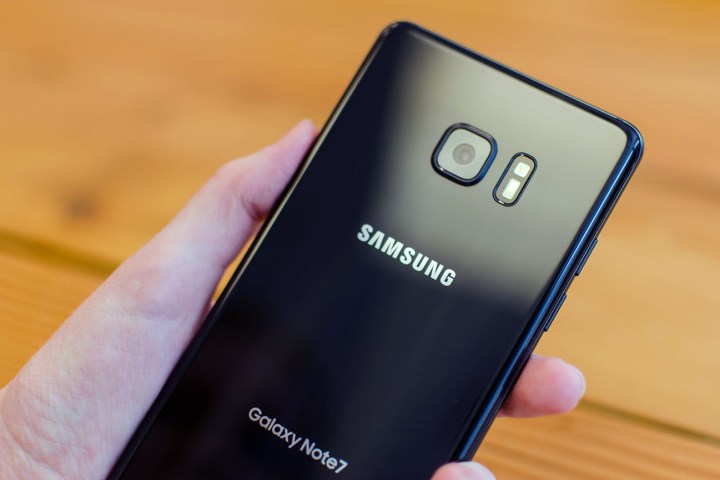
The truth about how and why the Galaxy Note 7 turned into such a fiery, spectacular failure was revealed to the public in a live-streamed press conference on Monday in the company’s home country of South Korea, where Samsung revealed the result of an elaborate investigation into the doomed device and details on what caused Note 7 units to overheat — and in some cases, burst into flame.
Samsung President of Mobile Communications Business DJ Koh, who led the presentation, began by announcing that 96 percent of about 3 million devices sold and activated had been returned. “I sincerely apologize … to all of our business partners,” Koh said. “We thank you for your patience and continuous support.”
What caused the explosions?
Koh said Samsung reviewed every potential cause of the of the Note 7’s defects, including its battery, hardware, software algorithms, manufacturing, and logistics. It retained the services of third parties including the Underwriters Lab safety consulting firm, the Exponent engineering and scientific consulting firm, and Germany’s TUV Rheinland. And it enlisted the help of 700,000 Samsung engineers across the four locations in which it manufactured its phones: Gumi, South Korea; Hanoi, Vietnam; and Huizhou and Tianjin, China.
Together, the parties tested more than 200,000 devices and over 30,000 batteries in a large-scale charge and discharge test facility that tested the impact of several features on overheating, including the Note 7 units’ fast-charging feature, wireless charging, USB Type-C voltage capacity, water resistance, software algorithms, and iris scanner.
Initially, the engineers didn’t observe any hardware or software anomalies, Koh said. But when they turned their focus to the phones’ batteries — which two suppliers custom-engineered for the Note 7, and which featured distinctive voltage specifications — they were able to replicate the overheating and explosions observed in consumer devices.
Engineers determined that “type A” batteries — the batteries included in the first crop of Note 7 devices shipped to market, supplied by Samsung’s SDI unit — short-circuited as a result of battery casing that didn’t have enough room to let the battery expand and contract during recharge cycles. Damage to the separator, a component within lithium-ion batteries that prevents the negative and positive electrodes from coming into contact and generating dangerous heat, occurred as a result, which led to overheating.
And it found that “type B” batteries — batteries in the second shipment of Note 7 units from second recall, designed by Hong Kong-based Amperex Technology — experienced component failure as a result of manufacturing and quality issues that occurred when Samsung increased its order to about 10 million new batteries. Protrusions in the battery were left over from the ultrasonic welding, the company said.
The path forward for Samsung
The company is putting in place preventative measures going forward. It’s introducing an eight-point inspection process that’ll include a visual inspection, an X-ray test, a charge/discharge test, a leakage test, a full disassembly and reassembly, an “extreme conditions” test, a voltage test, and a durability test of each phone battery. Cells bound for Samsung’s upcoming Galaxy S8 will undergo the inspection, Koh said.
Furthermore, Samsung’s adding staff dedicated to overseeing each battery feature’s safe implementation, Koh said. It’s making its intellectual property around battery safety and standards freely available, and it plans to share its new battery review process with global standards bodies.
“For customers, we have to develop innovation, but customer safety is the priority,” Koh said. “In the end, we can win the customers’ trust back.”
The presentation put an end to months-long speculation regarding the cause of the problem, which mostly centered around battery issues, safety checks, and adjustments to the way the device is manufactured over previous versions.
Samsung, citing the conclusion of three quality-control and supply-chain analysis, blamed manufacturing defects for the Note 7’s explosive tendencies. Specifically, it said that power cells provided by the company’s own battery division “didn’t fit properly” in the initial batch of Note 7 devices. And it said that batteries provided by ATL, a third party, experienced unspecified failures resulting from “quick ramp-up in production of replacement phones.”
Samsung’s Koh Dong-jin, the head of the smartphone division, said the announcement was intended to “clearly point out what caused the Galaxy Note 7 to catch fire and announce follow-up measures.” He expressed hope that it would help disgruntled Note 7 owners and prospective Samsung device buyers “regain confidence” in the brand.
It’s going to need the help. Samsung is expected to announce its next flagship smartphone, the Galaxy S8, in the next few months. And it will need to reassure potential buyers the devices are safe, won’t be recalled, and any manufacturing problems that affected the Note 7 haven’t been repeated.
While Samsung closed one awkward chapter in its recent history, another is still ongoing. In South Korea, the company’s vice chairman is at the center of a scandal involving bribery, embezzlement, and the impeachment of the country’s president.
Article originally published on 01-16-2016. Updated on 01-23-2017 by Kyle Wiggers: Added results of Samsung’s official report on Sunday.


